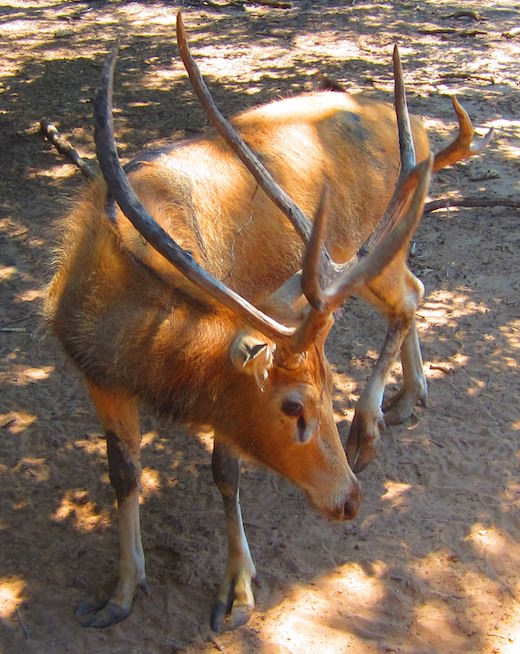Père David's Deer

Extinct in wild 1910
The Père David's deer had a reddish tan coat in the summer that changed to a dull gray in the winter. They had long, wavy guard hairs that were present on the outer coat throughout the year, however, the coat become woolier in the winter. The deer had a mane on its neck and throat. The tail was long and had a dark tuft at the end of it. The Père David's deer had a long, slender head with large eyes and preorbital glands. The nose pad was naked and it had small, pointed ears. The antlers branched with the long tines pointing backwards and the main beam extending upward. They are believed to have had two sets of antlers. The first antlers, summer antlers, were large and typically dropped in November. The second set, if there was one, were fully grown by January, but would fall off a few weeks later. Their hooves are large and spreading and make a clicking sound when the deer moves.
Habitat
The Père David's deer inhabited much of the China Proper. There were also antlers found at the settlements from the Liao River in the north to Jiangsu and Zhejiang Province. They were also found across the Yellow and Yangtze River basins in Shaanxi and Hunan Province. They are semi-aquatic which means they prefer marshland. They are native to the subtropics of China.
Extinction
The Père David's deer can only be found in captivity, they are officially extinct in the wild. By the late nineteenth century, the only herd left belonged to Tongzhi, the Emperor of China. They were kept in the Nanyuang Royal Hunting Garden in Nan Haizi. A heavy flood in 1895 knocked one of the gardens walls down. The deer that escaped were eventually killed and eaten by starving peasants. The deer that survived that were eventually killed by troops who took over the area, causing them to become extinct. However, a few of the Père David's deer were illegally transported to Europe for exhibition and breeding. A scientist bred the deer which eventually re-populated them. They were re-introduced to China in 1985. China was given a herd of twenty deer that included five males and fifteen females. They were then given eighteen more females in 1987, bringing the population up even more. The deer were re-introduced at the Beijing Milu Park which used to be the relic site for the Royal Hunting Garden, where the deer resided before their extinction. In 2005, the population of Père David's deer was up to around 2000. The deer can not be found in the wild, they are kept in captivity.